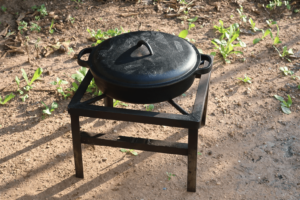The Importance of Trivets in the Kitchen
In the realm of kitchen essentials, a trivet may appear small and insignificant. However, this unassuming tool protects your dining table from heat damage, ensuring safe and stylish meal service. Let’s explore the rich history, various uses, and modern adaptations of the trivet.
What is a Trivet?
A trivet sits between a hot serving dish and the dining table to prevent heat damage. Traditionally, it features three or four legs, elevating the dish above the table. The term “trivet” originates from the Latin word tripes, meaning “tripod,” reflecting the three-legged designs of earlier models.
A Rich Historical Background
Ancient Origins
Trivets have a history dating back to antiquity. In ancient China, metal trivets were found in the tomb of Zhao Mo, a 2nd-century BCE ruler. Known as “fire stands,” these early trivets elevated pots above open fires, ensuring even cooking and preventing tipping.
Medieval Europe
During the Middle Ages, trivets evolved into intricate designs made from wrought iron and brass, showcasing craftsmanship while serving practical kitchen purposes.
Colonial America
In early American homes, trivets were essential for serving hot dishes, often crafted from wood or ceramic. They blended functionality with home aesthetics.

Contemporary Uses of Trivets
Today, trivets serve multiple functions and enhance your dining experience:
Heat Protection
Their primary role remains unchanged: safeguarding your dining table from heat damage. Whether it’s a sizzling casserole or a fresh pie, trivets protect your surfaces.
Design Variety
Trivets come in various materials and designs, allowing you to choose one that complements your table setting. From rustic wooden styles to sleek metal options, these accessories enhance your dining theme.
Versatility
Beyond serving dishes, trivets can function as cooling racks for baked goods or bases for hot pots and pans on countertops. Their versatility makes them indispensable in any kitchen.
Choosing the Right Trivet
When selecting a trivet, consider these factors to find the perfect fit:
Material Options
Wood: Classic look but may not withstand high heat.
Metal: Durable stainless steel or cast iron can handle high temperatures.
Silicone: Flexible, heat-resistant, and easy to clean.
Aesthetic Appeal
Choose a trivet that complements your kitchen decor. A visually appealing trivet can serve as a centerpiece, enhancing your meal’s overall ambiance.
Modern Adaptations
As kitchens evolve, so do trivets. Here are some contemporary adaptations reflecting current design trends:
Multi-functional Designs
Modern trivets may double as pot holders or decorative centerpieces when not in use.
Artistic Styles
Today’s trivets often feature artistic designs, from geometric patterns to nature-inspired motifs, transforming them from mere tools to pieces of art.
Sustainable Options
With a growing emphasis on sustainability, many manufacturers offer eco-friendly trivets made from recycled materials or sustainably sourced wood, catering to environmentally conscious consumers.

Caring for Your Trivet
To ensure your trivet lasts, follow these care tips:
Wood Trivets: Clean with a damp cloth and avoid soaking. Occasionally apply mineral oil to maintain the finish.
Metal Trivets: Clean with soap and water, drying immediately to prevent rust.
Silicone Trivets: Dishwasher safe; simply toss them in for easy cleaning.
Conclusion
In summary, a trivet is much more than a kitchen accessory—it’s an essential tool that protects your surfaces, enhances your dining experience, and showcases your style. With a rich history and a variety of modern adaptations, trivets continue to play a pivotal role in kitchens worldwide. So, next time you set the table, don’t overlook this small yet mighty item. Embrace the trivet as a blend of functionality and artistry, ensuring your meals are served safely and stylishly.





